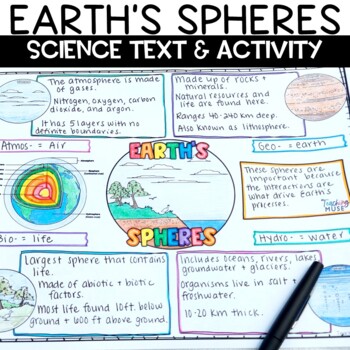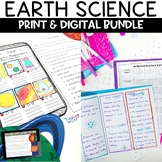Earth's Spheres (biosphere, hydrosphere, atmosphere, geosphere) Activity
- PDF
- Google Apps™

What educators are saying
Also included in
- Do you need ways to engage your earth science students on the topics of lunar phases, stars, galaxies, solar system, Earth's layers, Earth's rotation and revolution, tides, eclipses, weathering, erosion, rocks, and minerals? This bundle of earth science curriculum lessons offers a variety of learninPrice $45.00Original Price $63.99Save $18.99
Description
Teach your students about Earth's four spheres using this science text and activity. Students will read to learn about the atmosphere, biosphere, geosphere, and hydrosphere and then complete the graphic organizer activities to demonstrate their learning. Students will also read and answer scenarios about how the spheres interact with one another, and the impact humans have on Earth's spheres.
Like this Earth's spheres activity? Check out the Earth science bundle and save 20% by clicking here.
Students will learn:
- about each of Earth's spheres
- Atmosphere
- Biosphere
- Geosphere (sometimes referred to as lithosphere)
- Hydrosphere
- how the spheres interact with one another
- the impact humans have on the spheres
This Earth's spheres activity includes:
- Teacher instructions to distribute the digital version
- Two printable pages of science text with an additional page of comprehension questions
- Three graphic organizers
- Digital version of the printable materials
- Answer key
How to Use This Activity:
Science Text:
- Read through the science text together to allow students to learn about each of the four spheres. Students can highlight important information or use post its to take notes.
- Students could work together in pairs or small groups to read and understand the text.
- Assign the passage for homework and have the students complete the graphic organizers the following day.
Graphic Organizers:
- Use these varied sheets to assess student comprehension. Then, allow students to refer back to the text to pull out relevant details to summarize each sphere.
- Paste the graphic organizer onto chart paper and have students create a poster to show their knowledge of each sphere
This activity aligns to:
5-ESS2-1 Earth's Systems: Develop a model using an example to describe ways the geosphere, biosphere, hydrosphere, and/or atmosphere interact.
Science and Engineering Practices: Develop and use a model - Students will create a model using the graphic organizers to determine their understanding of Earth's spheres.
Crosscutting Concepts: System and system models, Scale, proportion, and quantity
Disciplinary Core Idea: Earth's materials and systems
Other lessons and activities to support this unit:
- Layers of the Earth activity
- Earth's revolution, rotation, and seasons activity
- Earth science DIGITAL bundle
Kindly Note: If you have questions, do not hesitate in emailing me at Teaching Muse Email
PLEASE PREVIEW BEFORE PURCHASING
____________________________________________________________________________________
Thank you for visiting Teaching Muse. I would love for you to become a follower.
Teaching Muse followers receive new product information and discounts on any new items!
____________________________________________________________________________________
All rights reserved by Teaching Muse. This product is to be used by the original downloader ONLY. Copying for more than one teacher, classroom, department, school, or school system is prohibited. Additionally, this product may not be distributed or displayed digitally for public view. Failure to comply is a copyright infringement and a violation of the Digital Millennium Copyright Act (DMCA). Intended for classroom and personal use ONLY.






